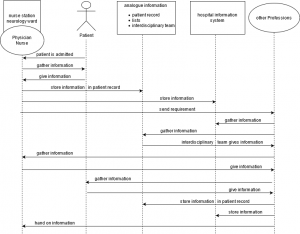Information transfer within interdisciplinary health teams. Designing a mockup for patient admission in a hospital. A qualitative pilot study.
Aim and Research Question(s)
The aim of this thesis was to find out how internal communication channels in an interdisciplinary health team look like with the focus on the admission process and how this can be supported digitally. Therefore, two research questions were formulated: What kind of information, that is already collected during the admission process, is needed by different health professions? How does a digital prototype aiming to assist the process of patient admission need to be structured to support interdisciplinary work?
Background
Interdisciplinary work in hospitals is the base, to optimise quality of treatment and patient care [1]. The everyday life in hospitals is controlled by different buisness processes and support processes, which are designed to ensure optimal patient care [2]. Some processes are supported with digital systems, however handwritten documentation procedures still predominate. Through these handwritten documentation procedures, information is not accessible at any point of time, information is often incomplete, and it is difficult to combine information of analogue and digital systems [3].
Methods
A qualitative pilot study combined with a user-centred design approach was conducted. Eleven different health professions working at the neurology ward of a private hospital were interviewed. Subsequently, a qualitative content analysis according to Mayring was conducted, in which a category system was created. Based on the results of the content analysis, a mockup design was created aiming to digitally support the admission process.
Results and Discussion
The results show that information transfer is supported both analogously and digitally, although analogue processes are predominating. The process of hospital admission is mostly handwritten, and information has to be collected by professionals within different documentation systems, see figure 1. Different health disciplines describe the need to get an overall impression of a patient before the first patient encounter. The mockup design shows one possibility in which this can be achieved with digital support of the processes in patient admission.
 Figure 1: Main processes of information transfer within the interdisciplinary health team.
Figure 1: Main processes of information transfer within the interdisciplinary health team.
Conclusion
In summary, a digitally supported admission process provides the opportunity to get a comprehensive picture of a patient, which in turn enhances interdisciplinary collaboration in healthcare teams.
References
[1] WHO, 2010, ‘Framework for Action on Interprofessional Education & Collaborative Practice’ [2] M. Kramer, 2008, Qualitäts- und Prozessmanagement für mehr Kundenorientierung: Aktuelle Managementformen im Krankenhaus. [3] J. Klauber et al, 2019, Das digitale Krankenhaus, doi: 10.1007/978-3-662-58225-1.
